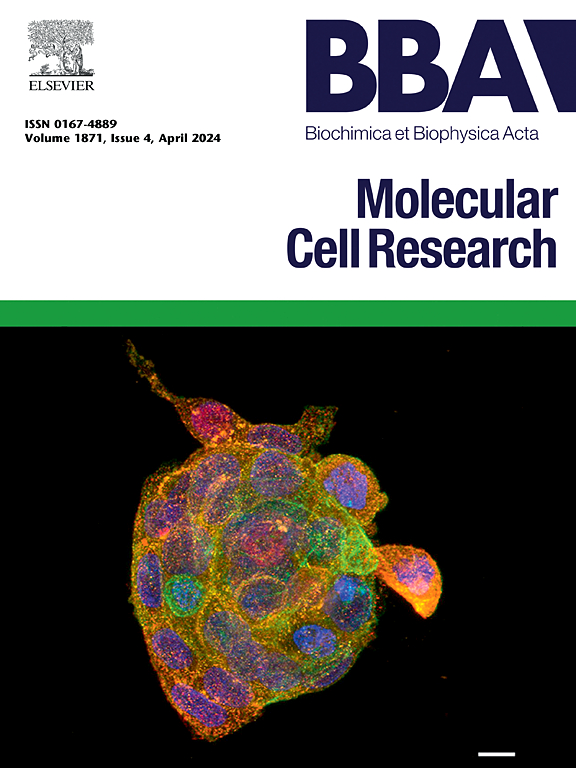m6A-mediated regulation of ECA39 promotes renal fibrosis in chronic kidney disease by enhancing glycolysis and epithelial-mesenchymal transition
IF 3.7
2区 生物学
Q1 BIOCHEMISTRY & MOLECULAR BIOLOGY
Biochimica et biophysica acta. Molecular cell research
Pub Date : 2025-04-30
DOI:10.1016/j.bbamcr.2025.119981
引用次数: 0
Abstract
Renal fibrosis is a vital pathological manifestation of chronic kidney disease (CKD). ECA39 is a conserved gene in the regulation of cell behavior; however, its function in renal fibrosis remains unclarified. A murine model of renal fibrosis was established by unilateral ureteral obstruction (UUO) operation. ECA39 expression was significantly upregulated in the kidneys of UUO mice. Prior to UUO operation (14 days), mice were administrated adeno-associated virus serotype 9 (AAV9, 1 × 1011 vector genomes) expressing ECA39 shRNA via tail vein injection. At postoperative day 7, AAV9-mediated inhibition of ECA39 was found to mitigate UUO-induced kidney damage, as manifested by reduced NGAL expression in kidneys, along with reduced serum creatinine and blood urea nitrogen (BUN) levels. Inhibition of ECA39 decreased collagen I, α-SMA and vimentin expression, but increased E-cadherin in kidney tissues. ECA39 inhibition reduced serum lactic acid level, increased ATP production, and suppressed glycolysis-related indicators HK2, PFKM, PKM2, PDK1, and LDHA expression. In parallel, human proximal tubular epithelial cells (HK−2) were treated with TGF-β1 (5 ng/ml, 48 h) to induce a cellular model of injury. ECA39 knockdown inhibit epithelial-mesenchymal transition (EMT) and glycolysis in HK-2 cells. Mechanistically, TGF-β1 treatment increased m6A modification of ECA39 mRNA, and the m6A “reader” IGF2BP2 knockdown reduced ECA39 mRNA stability. IGF2BP2 knockdown reduced lactic acid content and inhibited EMT in HK-2 cells, whereas ECA39 overexpression reversed these effects. Collectively, our studies demonstrated that inhibition of ECA39 suppresses glycolysis and EMT processes, thereby alleviating renal fibrosis in CKD.

m6a介导的ECA39调节通过增强糖酵解和上皮-间质转化促进慢性肾病肾纤维化
肾纤维化是慢性肾脏疾病(CKD)的重要病理表现。ECA39是调控细胞行为的保守基因;然而,其在肾纤维化中的作用尚不清楚。采用单侧输尿管梗阻(UUO)手术建立小鼠肾纤维化模型。UUO小鼠肾脏中ECA39表达显著上调。在UUO手术前(14天),小鼠通过尾静脉注射表达ECA39 shRNA的腺相关病毒血清型9 (AAV9, 1 × 1011载体基因组)。术后第7天,发现aav9介导的ECA39抑制可减轻uuo诱导的肾损伤,表现为肾脏NGAL表达降低,血清肌酐和血尿素氮(BUN)水平降低。抑制ECA39可降低肾组织中I型胶原、α-SMA和vimentin的表达,增加E-cadherin的表达。ECA39抑制降低了血清乳酸水平,增加了ATP的产生,抑制了糖酵解相关指标HK2、PFKM、PKM2、PDK1和LDHA的表达。同时,用TGF-β1 (5 ng/ml, 48 h)处理人近端小管上皮细胞(HK−2),诱导细胞损伤模型。ECA39敲低抑制HK-2细胞上皮-间质转化(EMT)和糖酵解。机制上,TGF-β1处理增加了ECA39 mRNA的m6A修饰,m6A“读取器”IGF2BP2敲低降低了ECA39 mRNA的稳定性。IGF2BP2敲低可降低HK-2细胞中的乳酸含量并抑制EMT,而ECA39过表达可逆转这些作用。总的来说,我们的研究表明,抑制ECA39可以抑制糖酵解和EMT过程,从而减轻CKD的肾纤维化。
本文章由计算机程序翻译,如有差异,请以英文原文为准。
求助全文
约1分钟内获得全文
求助全文
来源期刊
CiteScore
10.00
自引率
2.00%
发文量
151
审稿时长
44 days
期刊介绍:
BBA Molecular Cell Research focuses on understanding the mechanisms of cellular processes at the molecular level. These include aspects of cellular signaling, signal transduction, cell cycle, apoptosis, intracellular trafficking, secretory and endocytic pathways, biogenesis of cell organelles, cytoskeletal structures, cellular interactions, cell/tissue differentiation and cellular enzymology. Also included are studies at the interface between Cell Biology and Biophysics which apply for example novel imaging methods for characterizing cellular processes.

 求助内容:
求助内容: 应助结果提醒方式:
应助结果提醒方式:


